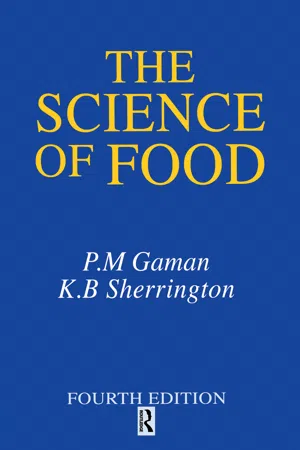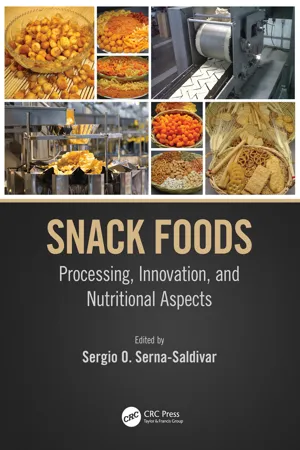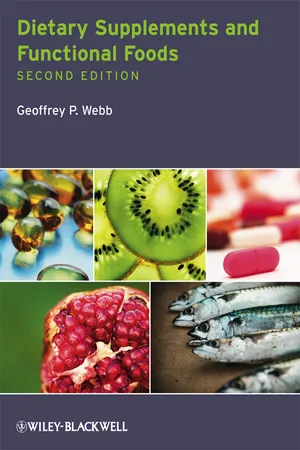Fats and Oils
Fats and oils are organic compounds composed of fatty acids and glycerol. They are a type of lipid and are essential for energy storage, insulation, and cell membrane structure. Fats are solid at room temperature, while oils are liquid. Both fats and oils are important in the human diet and are used in cooking and food preparation.
7 Key excerpts on "Fats and Oils"
- eBook - ePub
- K. B. Sherrington, P. M. Gaman(Authors)
- 2010(Publication Date)
- Routledge(Publisher)
...6 Fats and Oils (Lipids) Fats and Oils, also known as lipids, are like carbohydrates in that they contain the elements carbon, hydrogen and oxygen. They are esters of glycerol and fatty acids (see Chapter 3). Glycerol is a trihydric alcohol, i.e. it has three —OH groups. The general formula of a fatty acid (alkanoic acid) is RCOOH where R represents a hydrocarbon chain. Each — OH group of the glycerol reacts with the —COOH of a fatty acid to form a molecule of fat or oil. This is an example of a condensation reaction (see page 60). Fats and Oils are mixtures of triglycerides. A triglyceride consists of one molecule of glycerol combined with three fatty acid molecules, as shown in the above equation. Diglycerides consist of glycerol combined with two molecules of fatty acid, and in monoglycerides only one fatty acid molecule is present. Diglycerides and monoglycerides are used as emulsifiers (see page 54). The simplest type of triglyceride is one in which all three fatty acids are the same. However, triglycerides usually contain two or three different fatty acids and are known as mixed triglycerides. Naturally occurring Fats and Oils are mixtures of different mixed triglycerides and therefore may contain a number of different fatty acids. There are about 40 different fatty acids found in foods. There are basically two types: 1 Saturated fatty acids in which the hydrocarbon chain is saturated with hydrogen 2 Unsaturated fatty acids in which the hydrocarbon chain is not saturated with hydrogen and therefore has one or more double bonds. Unsaturated fatty acids may be either: monounsaturated – containing one double bond, e.g. oleic acid; or polyunsaturated – containing more than one double bond, e.g...
- eBook - ePub
- S. P. Bhutani(Author)
- 2019(Publication Date)
- CRC Press(Publisher)
...5 Lipids-Oils and Fats Learning Objectives In this chapter we will study • What are Lipids? • Classification of Lipids • Biological Functions of Lipids • Oils and Fats as Simple Lipids • Fatty Acids – Their Composition in Some Fats and Oils • Omega–3 and Omega–6 Fatty Acids • Biological Role of Fatty Acids • Trans Fats and their Effect on the Heart and Brain • Effect of Fats on Blood Cholesterol Levels • Extraction of Oils and Fats • Refining of Oils and Fats • Hydrogenation • Identification of Oils and Fats • Flavour Changes in Oils and Fats, Rancidity • Cholesterol • Importance of Triglycerides • Lipid Membranes • Liposomes 5.1 WHAT ARE LIPIDS? Lipids are broadly defined as any fat-soluble naturally occurring molecules. They are insoluble in water but soluble in ether, chloroform and hot alcohol. Lipids include many types of compounds containing a wide variety of functional groups such as fats, oils, waxes, cholesterol, sterols, fat-soluble vitamins (A, D, E and K), phospholipids and others. Lipids constitute a major part of stored food material in animals and human beings and a major structural component. The main biological functions of lipids include energy storage, acting as structural components of cell-membranes and participating as important signalling molecules. Although the term lipid is sometimes used as a synonym for fats, fats are a subgroup of lipids called triglycerides and should not be confused with the term fatty acid. Lipids also include molecules such as fatty acids and their derivatives, cholesterol and all other compounds obtained from cholesterol. Terpenoids and carotenoids also come under lipids. Lipids are hydrophobic in nature. They originate entirely or in part from two distinct types of biochemical subunits or “building blocks”–ketoacyl and isoprene groups. We consume oils and fats in our daily diet...
- eBook - ePub
Snack Foods
Processing, Innovation, and Nutritional Aspects
- Sergio O. Serna-Saldivar, Sergio O. Serna-Saldivar(Authors)
- 2022(Publication Date)
- CRC Press(Publisher)
...7 Production and Properties of Fats and Oils Sergio O. Serna-Saldivar DOI: 10.1201/9781003129066-7 Contents 7.1 Introduction 7.2 Oilseeds and Oil-Bearing Fruits 7.3 Organogels 7.4 Animal Fats 7.5 Oil Extraction and Refining 7.5.1 Oil Extraction Processes 7.5.1.1 Mechanical Extraction 7.5.1.2 Solvent and Dual Extraction 7.5.2 Oil Refining 7.5.2.1 Chemical Refining 7.5.2.2 Physical Refining 7.6 Modification of Functional Properties of Oils 7.6.1 Blending 7.6.2 Winterization and Fractionation 7.6.2.1 Winterization or Dewaxing 7.6.2.2 Fractionation 7.6.3 Hydrogenation 7.6.4 Intra e Interesterification 7.7 Trans Fats References 7.1 Introduction Fats and Oils have always been an important part of the human diet. Among all nutrients, lipids provide the highest amount of energy per unit weight (9 kcal/g). In addition, some lipid materials carry important fat-soluble vitamins such as A, D, E and K and liposoluble nutraceuticals like phospholipids and phytosterols (Chapter 21). Most lipids consumed are triacylglycerol or triglycerides composed of three fatty acids (FA) esterified to a molecule of glycerol. These are considered the main reserve lipids in plant and animal tissues where they are stored in spherosomes and adipocytes, respectively. Fats and Oils differ in properties and applications due to their FA composition consisting of an aliphatic chain containing from 4 to 26 carbons with a terminal carboxy group (COOH). The carboxyl group esterifies with the glycerol forming mono, di or triglycerides, and these molecules are broken down by lipases during digestion. All FA are produced from acetyl Co-A and therefore the molecule is built by adding two carbons. That is the reason why most FA contain an even number of carbons. The FA can be saturated, monounsaturated or polyunsaturated. The saturated does not contain double bonds whereas the monounsaturated and polyunsaturated contain one and two or more double bonds, respectively...
- eBook - ePub
Handbook of Molecular Gastronomy
Scientific Foundations, Educational Practices, and Culinary Applications
- Christophe Lavelle, Herve This, Alan L. Kelly, Roisin Burke, Christophe Lavelle, Herve This, Alan L. Kelly, Roisin Burke(Authors)
- 2021(Publication Date)
- CRC Press(Publisher)
...Fats and Oils: Physicochemical Properties of Edible Oils and Fats Sabine Danthine Science des Aliments et Formulation, Gembloux Agro-Bio Tech, University of Liège, Avenue de la faculté d’Agronomie 2B, 5030 Gembloux, Belgium Oils and fats are highly abundant compounds in nature and are widely used in food and other industrial products. Their behaviour heavily influences the microstructure and physical properties of fat-based products, such as chocolates, confectionery, margarine and butter. Edible oils and fats are complex mixtures of lipidic components. They mainly contain triacylglycerols (TAG): three fatty acids esterified on a glycerol backbone (Figure 41.1). FIGURE 41.1 Schematic representation of a triacylglycerol molecule. R, R′ and R″ are fatty acids. The functionalities of fats in edible products are on the one hand, to provide nutritional characteristics and on the other hand, to provide structure. Both directly depend on the TAG composition: from the nutritional point of view, an increased use of lipids made of polyunsaturated fatty acids (liquid oils) is desirable, whereas the physical structuring of food products requires saturated lipids (solid fats). The properties of the fat crystal network formed in the products determine their functional properties. The mechanical strength of the underlying fat crystal network determines many of the sensory attributes, such as hardness, spreadability, mouthfeel and also snap in the case of chocolate. The physical properties of natural oils and fats vary widely, even though they are generally made of similar fatty acids. The relative proportions of these fatty acids and also their disposition within the TAG are the reasons for these differences. In general, the longer and the more saturated the hydrocarbon chains, the more solid are the molecules...
- eBook - ePub
- Geoffrey P. Webb(Author)
- 2011(Publication Date)
- Wiley-Blackwell(Publisher)
...6 Natural Fats and Oils The nature of fats, oils and other lipids The principal component of dietary Fats and Oils is triacylglycerol (TAG), which is made up of three fatty acids attached by ester linkages to the simple three-carbon carbohydrate glycerol. These three fatty acids can be all the same (simple TAG) or different (mixed TAG). These fatty acids are composed of a hydrocarbon chain of variable length and a carboxyl (COOH) or acid group at one end (see Figure 6.1). Figure 6.1 The chemical nature of fat and the structure of fatty acids. Source: G.P. Webb (2008) Nutrition: A Health Promotion Approach, 3rd edn. p. 264. Arnold, London. Palmitic acid (shown in Figure 6.1) is described as a saturated fatty acid because all of the carbons in the hydrocarbon chain are joined together by single bonds and all of the available valencies of the carbon atoms in this chain are ‘saturated’ with hydrogen. No more hydrogen atoms can be added into this hydrocarbon chain. Fatty acids that have two or more of the carbons in the hydrocarbon chain joined by a double bond are termed unsaturated fatty acids. Under the right chemical conditions more hydrogen atoms can be added into this hydrocarbon chain; they are not saturated with hydrogen and two more hydrogen atoms can be added at the site of each double bond. Fatty acids with just one double bond in the hydrocarbon chain are termed monounsaturated (one point of unsaturation) and those with more than one are termed the polyunsaturated fatty acids. Oleic acid, illustrated in Figure 6.1, is an example of a monounsaturated fatty acid; and α-linoleic acid and eicosapentaenoic acids, also shown in Figure 6.1, are examples of polyunsaturated fatty acids. Fatty acids with double bonds have lower melting points than the equivalent saturated fatty acid; the higher the number of double bonds, the lower is the melting point (see Table 6.1 for examples of melting points of saturated and unsaturated fatty acids)...
- eBook - ePub
Functional Foods
Principles and Technology
- Mingruo Guo(Author)
- 2013(Publication Date)
- Woodhead Publishing(Publisher)
...It also presents a brief description of olive and fish oils, phytosterols, as an important source of healthy diet and their health beneficial effects. “Lipids” is a word derived from the Greek “lipos” meaning fat. However, there is no widely accepted definition of lipids. Over the years, the term lipids have been used interchangeably to describe a group of naturally occurring compounds that are soluble in organic solvents (e.g., hexane, chloroform, ether, alcohol) and insoluble in aqueous media. However, lipids also includes a series of other compounds that have little similarities either in structure or in function such as carotenoids, terpenes, steroids and their naturally occurring derivatives. Many of these naturally occurring compounds are partially soluble in water as well. The definition of lipids simply based on solubility is not justifiable and should be widened to include compounds that are related closely to fatty acid derivatives through biosynthetic pathways or by their biochemical or functional properties. Lipids serve as structural components of biological membranes and provide energy in the form of triacylglycerol (TAG) also called as triglycerides. Lipids are considered in relation to excess energy balance, obesity, and as a dietary factor in the development of cardiovascular disease and many other harmful disorders. However, not all lipids are bad and damaging to human health. In fact some play a unique role in maintaining good health and providing much of the flavor and texture to foods. The changing trend in our food supply and the industrial revolution have in fact jeopardized both the quantity and balance of these nutrients. The polyunsaturated fatty acids (PUFA), for example, are very beneficial and should be consumed on a regular basis. These include the n-3 and n-6 (also referred as omega-3 or ω-3; and omega-6 or ω-6) PUFA, also known as essential fatty acids (EFA)...
- eBook - ePub
- Jose Perez-Castineira(Author)
- 2020(Publication Date)
- De Gruyter(Publisher)
...All chemical formulae were retrieved and adapted from: https://www.lipidmaps.org/data/structure/LMSDSearch.php. 4.3 Triacylglycerides: edible Fats and Oils The terms fat and oil are used in normal speech for solid and liquid lipids, respectively, at room temperature (20–25 °C). All foods contain lipids at varying concentrations [ 13 ]: Vegetables and fruits contain an average 0.3% (expressed as percentage of wet mass) with some exceptions like avocado, whose edible portion contains about 20% lipids. Muscle tissue of lean beef, fish, white poultry, and shell fish: 2%. Cow’s milk: 3.7%. Grains: 2–4%. Fatty pork: 30% Egg yolk: 32% Fillets of fatty fish (tuna, salmon …): 35% Oil bearing nuts and seeds: from 20% in soybeans to 65% in walnuts. Vegetable oils are the main lipid sources in the human diet (Table 4.4), especially those obtained from palm, soybean, rapeseed, and sunflower seed, that account for more than 75% of world production; however, animal fats like butter, lard, tallow, and fish oil still provide a significant part of global fat production and consumption (around 13%) [ 14 ]. Other minor sources include nut, cereals, and legumes [ 15 ]. Table 4.4: Production of major vegetable oils worldwide in 2017/2018. Source Production in million metric tons Palm 69.28 Soybean 54.95 Rapeseed 28.48 Sunflower seed 18.37 Palm kernel 8.17 Peanut 6.09 Cottonseed 5.16 Coconut 3.54 Olive 3.27 Source: https://www.statista.com/statistics/263933/production-of-vegetable-oils-worldwide-since-2000/. Retrieved on 19/2/2019 Dietary Fats and Oils are mainly constituted by esters of fatty acids and glycerol, that can be subdivided into tri(acyl)glycerols (TAGs), the most abundant, 1,2- or 1,3-di(acyl)glycerols, and 1- or 2-mono(acyl)glycerols, according to the number and position of acyl groups. In the case of TAGs, when the two primary hydroxyl groups of glycerol are esterified with different fatty acids, the resulting molecule displays chiral asymmetry...






